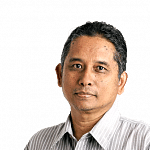PALEMBANG, South Sumatra - Sending tents and medical supplies to flooded areas. Check.
Ferrying ready-to-eat meals and blankets to volcano-hit zones. Check.
Rebuilding collapsed schools and bridges in post-earthquake reconstruction. Check.
These are the hardcore disaster response works regularly done by Singapore humanitarian organisation Mercy Relief (MR) since it was launched 10 years ago, with donations from the Singaporean public and the private sector.
But today, the group has expanded its focus and you might want to consider calling it Doomsday Preppers Lite.
In South Sumatra province, Governor Alex Noerdin praised Mercy Relief in a public speech this week for its work in training caregivers of and families with disabled children.
And in the same week, the Indonesian province held a public event to celebrate an MR-initiated course for local teachers to bring basic English to rural students.
Huh?
What do the Special Needs Training programme and the English For Everyone projects have to do with Mercy Relief?
After all, its officials and volunteers are often seen in media images distributing relief goods from atop trucks in disaster-wrecked countries. Isn't that its main role?
And indeed, it has been involved in humanitarian efforts in more than 20 countries, including headline-grabbing events such as the 2004 Aceh tsunami, the 2008 cyclone Nargis in Myanmar, and the 2011 earthquake and tsunami in Japan.
The latest projects in South Sumatra, in fact, underline how the organisation has steadily expanded its focus in recent years from just reacting to disasters, to a deeper involvement with vulnerable rural communities to build up their capacity and preparedness.
In official-speak, this is MR's Sustainable Development Programme, or SDP.
"It is important that we build the capacity and preparedness of impoverished communities at disaster-prone locations. Poverty breeds vulnerability," said Mr Hassan Ahmad, Mercy Relief's chief executive, who was in Palembang with its workers.
Its move to strengthen rural communities and mitigate disaster risks can be gleaned from its average annual budgets in the last few years, where 30 per cent of its S$5 million to S$6 million annual budgets, have been allocated for longer-term development projects, whilst 50 per cent is for disaster relief, and the remainder for its overheads.
Compare these figures with its first five years where 90 per cent of the group's annual budgets were set aside for delivering emergency relief to disaster zones.
The SDP included converting ship containers into evacuation shelters in typhoon-prone central Vietnam; enhancing medical facilities in flood-prone Cambodia, and initiating the English For Everyone courses in Laos.
No, Mercy Relief is not abandoning its disaster-relief efforts.
Mr Hassan said that getting close to foreign state officials, municipal authorities, NGOs and the communities in the rural areas helps increase preparedness and response for future disasters.
"Such longer-term works build goodwill, trust and confidence with local communities and governments in disaster-prone areas. This will help us respond faster when there is a disaster in the area," he said.
In South Sumatra, for instance, the programme to impart techniques to help disabled children in South Sumatra, has been well received, with Governor Alex saying on Tuesday that the provincial government will bring in more funds to support the extension of the Mercy Relief project.
For Mr Hassan, the trust of the government of South Sumatra, which is located to the south of Singapore across the Malacca Strait, would give Mercy Relief the platform to prepare for what he calls "The Next Big One" threatening Sumatra. Others might call it the Doomsday scenario.
Some explanation: In the United States, there are groups which actively prepare for what they call Doomsday scenarios - such as the complete breakdown of society or a global meltdown in the financial system.
They "prepped" themselves by building underground bunkers and stocking up on dry food. These people are called the Doomsday Preppers. There is even a TV reality show on this group.
For Mr Hassan, who has been involved in several major earthquakes in many parts of Sumatra island, The Next Big One is the prediction by experts over the years that a huge earthquake could hit the western part of Sumatra in the near future.
Earthquakes have hit provinces such as North Sumatra, West Sumatra and Bengkulu which are neighbouring or nearby provinces of South Sumatra, with Palembang as its capital.
With South Sumatra itself free from earthquakes, Mercy Relief is working with the government to use the province as a possible launching pad for disaster relief should The Next Big One arrive.

